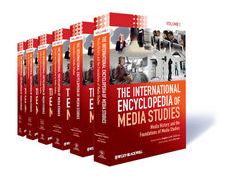 With more than 175 essays written by over 200 researchers from across the globe, the recently published International Encyclopedia of Media Studies is the most extensive resource at hand for those studying new media. The encyclopedia is divided into six parts. Geert Lovink contributed to the last volume, Media Studies Futures, with two articles.
With more than 175 essays written by over 200 researchers from across the globe, the recently published International Encyclopedia of Media Studies is the most extensive resource at hand for those studying new media. The encyclopedia is divided into six parts. Geert Lovink contributed to the last volume, Media Studies Futures, with two articles.
Media Studies: Diagnostics Of A Failed Merger. ‘According to Geert Lovink, there is no such thing as a “visual culture” that connects film, television, video, and new media. In this chapter, he argues that this mistaken belief has led to the naïve notion that we are all working on the same project, “the media.” In fact, Lovink argues, humanities-based “media studies” has never had a grip on new media and Internet education. The idea that media are all about images is contradicted by the reality of computers that run on code. A deep institutional confusion holds that new media are ultimately subordinate to the old content-based broadcasting industries and their outdated revenue models. This essay argues for a long overdue goodbye to the convergence tendencies within media studies departments in favor of full autonomy of new media initiatives. The purpose of critical research into digital technologies is not to rescue the film and broadcasting industries but to develop concepts for the ever-expanding digital realm itself.’
And with Ned Rossiter: In Praise of Concept Production: Formats, Schools, and Nonrepresentational Media Studies. ‘In this chapter, Lovink and Rossiter argue that the field of media studies has yet to develop a theory of itself. Audience studies investigated fandom and the production of meaning, textual analysis preoccupied itself with signification processes attached to content, and political economy turned its gaze on institutional power. Medium theory, while close to the authors’ own interests, still falls short, they argue, because it never changed the dialectic between old and new media or gave the relation a productive twist. Medium theory established a continuum between old and new media without considering how the media form itself gives rise to the production of new concepts. Media studies desperately needs new concept production, the authors argue, based in both online and face-to-face collaborative efforts. To develop new concepts, media researchers should begin with some reflexive mediation, examining how they use their object of study in the research methodology itself. From there, Lovink and Rossiter advocate moving the agenda beyond the analysis of visual representation to mobile media, miniaturization, smart technologies, and the integration of media into urban environments.’
From the back cover: Truly global in scope and covering a diverse range of topics, The International Encyclopedia of Media Studies provides the definitive resource for students, scholars, and faculty in this rapidly evolving and dynamically complex field. The Encyclopedia brings together cutting-edge scholarship from over 200 contributors, arranged thematically across 6 volumes edited by an international team of the world’s best scholars and teachers. The volumes explore the history and foundations of the field; production; content and representation; audience and interpretation; media effects and cognition; and the future of the field. Each opens with an accessible introduction that also serves as a stand-alone overview of the particular theme.
Reflecting the diversity of the field, the full breadth of Media Studies’ quantitative and qualitative methodologies is covered within these 175 essays, including the important contributions made by the social scientific paradigm in terms of effects and cognition; humanistic and historical approaches; and the Political Economic paradigm. Rather than pitting these approaches against each other, the encyclopedia includes them in productive conversation with each other and creates a new dimension of understanding. Chapters offer in-depth explorations of the historical background and recent developments, problems and challenges, and future opportunities for research that have evolved within the discipline. The Encyclopedia is also available online on Wiley Online Library, offering you 24/7 access, downloadable chapters, and powerful browsing and searching functionality. Visit www.encyclopediaofmediastudies.com.

